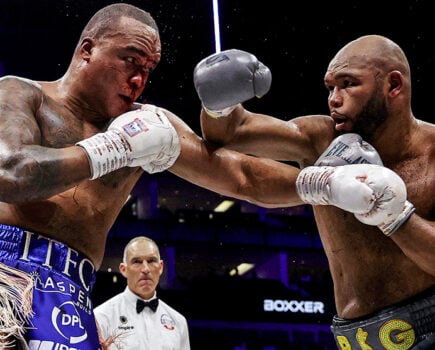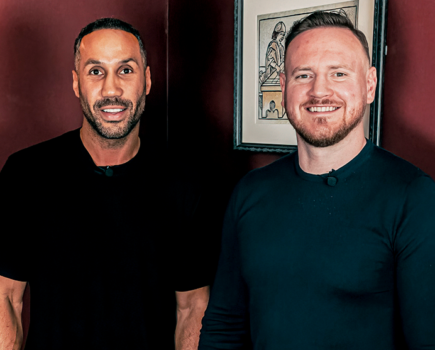By Declan Warrington
WHEN Larry Holmes first retired after successive and unexpected defeats by Michael Spinks that stopped him equalling and surpassing Rocky Marciano’s 49-0 record, he had already permanently established himself among the finest heavyweights to have lived.
When he was then offered the chance to fight Mike Tyson – 21 months after retiring following the second of those defeats he found so difficult to accept – he was presented with a chance to not only earn $3.1million, but to secure a victory that would have enhanced his reputation even more than had he beaten Spinks and another opponent and retired undefeated with 50 wins.
With Tyson – 21 that night in January 1988 – in his near-unrivalled-but-short-lived prime and still to start unravelling, it is not an exaggeration to say that Holmes, at 38 and after a period of inactivity, was fighting an opponent greater even than Ken Norton and Gerry Cooney were on his two defining nights.
“As I neared the ring, I had this weird thought,” Holmes once said of his recognition that he was under-prepared for “Iron Mike” at the Convention Centre in Atlantic City. “Why not be the first fighter to refuse to go into the ring? All those people watching on HBO, I’ll amaze all of them. I’ll tell the announcer, ‘I swear I’ll fight Tyson next month, right after I have a tune-up. Just not tonight’.”
By then – as with so many of his contemporaries equally no longer able to avoid the reality of what they were confronting – he of course essentially had no choice but to proceed. Having been tempted to return for the money he had been offered and already planned to invest in property, Holmes would not only have to combat the world’s leading and most dangerous heavyweight, but also the effects of inactivity and age.
If there were times he had cause for encouragement and as the veteran controlled the pace of their fight, as on so many other occasions throughout Tyson’s career, when the young champion found his range and started landing with power to his opponent’s head and chin, the ending proved as dramatic as it did swift.
Holmes – having never previously been stopped and having recovered from a knockdown to beat the even heavier-handed Earnie Shavers – was dropped three times in the fourth round, prompting the referee Joe Cortez to rescue him with five seconds remaining. Tyson – not unlike had Holmes eight years earlier against Muhammad Ali – was considered to have finally ended the career of a great champion.
“I hated the way I lost against Spinks,” Holmes, a grandfather approaching his fifth decade, had said beforehand. “Win 48 and then lost two like that. That’s why I came back. One way or the other, this time I will retire at peace with myself, and with honour.”
Given his third successive defeat had been his first by stoppage, whether he had achieved a sense of peace or bought the property of his dreams he appeared to have little choice. The heavyweight division, led by Tyson and soon Evander Holyfield, was moving beyond him, and the money Holmes could once have demanded would ultimately no longer be within his reach.
“Something told me to come out of retirement, to get on this platform and do my thing,” Holmes could be heard saying little over three years later ahead of his next fight, with Tim “Doc” Anderson – a natural cruiserweight selected to help him demonstrate he could still win. “Something told me I can do it.”
It was no coincidence that by then George Foreman, the one great heavyweight to elude Holmes at his peak, was nearing completing perhaps the most remarkable of all comebacks. After 10 years of retirement and another four returning to world level he was on the cusp of becoming the world’s oldest heavyweight champion. In retirement Holmes would have watched knowing that he was not only younger, but fresher, and also that a fight between the two of them could generate the type of money that was otherwise beyond him.
Like Foreman he first fought lightly regarded opponents and did so regularly in an attempt to rid himself of the ring-rust of the previous few years. His date with Anderson – Foreman himself had stopped Anderson in 1987 – came over three years after his near-four rounds with Tyson, lasted 123 seconds, and was overshadowed by his infamous brawl with Trevor Berbick later that night.
From then – April 7, 1991 – until November 12 Holmes fought a further four times, beating Eddie Gonzales, Michael Greer, Art Card and Jamie Howe and, against both Gonzales and Card, getting 10 valuable rounds. His five victories were perceived to count for little, however, when it was announced he would be fighting the undefeated Ray Mercer next.
Mercer was not only young, and powerful – in the same year Holmes lost to Tyson, Mercer had won Olympic gold. If at first there were concerns surrounding Holmes’ safety, there was also an awareness he was being used to enhance Mercer’s reputation, given plans existed to match him with Holyfield.
That many of those at the Convention Centre had booed Holmes into the ring was a reflection of the perception that the then-42-year-old had returned only for money. When he then followed being hurt and fighting clumsily by rediscovering his range and rhythm, that most effective of all jabs and occasional right hand started to discourage the Olympic champion, and to the extent that by the middle rounds he both looked on course for victory and had the crowd on his side.
Holmes – and in many respects he had long been a fighter beyond his years – fought like the classic veteran heavyweight. There were times he taunted Mercer and set traps he fell for, and others when he’d rest by lying on the ropes. By the time their fight was concluding there was little question Holmes was heading for one of his greatest victories; in a symbol of his dominance, the previously effervescent Mercer was bleeding from his nose.
“He scared the heck out of me,” Holmes, the winner via unanimous decision, fittingly said before it was revealed that he had suffered a detached retina beforehand and was fighting with limited sight. “He caught me off-balance, he hit me and he hurt me, but the oldness in me said, ‘No, you ain’t gonna fall’.”
At Mercer’s expense Holyfield – who had defeated Foreman the previous year – was in June 1992 scheduled to defend against Holmes the IBF, WBA and WBC titles, and Holmes, for his contribution to an occasion he was given more chance of winning than when fighting Mercer, would be paid $7m. In a way the great Holyfield never was he proved capable of lasting the distance without sustaining significant punishment, but even having occasionally landed the calibre of punches that snapped Holyfield’s head back and become the first to cut him, he too rarely outboxed him, and at Las Vegas’ Caesars Palace – the scene of his greatest triumphs – he ultimately fell to a unanimous decision defeat. Tellingly, the veteran projectile vomited at the sound of the final bell.
If that was again expected to be the last fight of Holmes’ comeback, he was again determined to continue to prove observers wrong, and little over six months later, at the Mississippi Coast Coliseum in Biloxi, he convincingly outpointed the little-known Everett Martin over 10 rounds. As until fighting Holyfield he again proceeded to remain busy – by also defeating Rocky Pepeli, Ken Lakusta, Paul Poirier, and Jose Ribalta over the following nine months, and then in outpointing Garing Lane and Jesse Ferguson over 10 rounds during 1994.
When he was then matched with Oliver McCall he represented the new WBC champion’s first challenger, and little over six months after McCall had stopped Lennox Lewis, previously recognised as one of the finest heavyweights in the world. For six rounds that night in April 1995 at Caesars Palace Larry appeared on course for an upset victory, yet in the same way he had previously faded, McCall also forced a strong finish to narrowly secure victory via scores of 114-113, 115-114 and 115-112 on the last time he would fight for a version of heavyweight championship of the world.
“This is a good fight for me to go out on,” Holmes said as accurately as ever and appearing to mean it, and yet the prospect of fighting Foreman was prominent among the reasons he continued to fight on. Five months later he outpointed Ed Donaldson, and in the following nine months – against Curtis Shepard, Quinn Navarre and Anthony Willis – he won a further three times. Decreasingly recognised as the fighter who had once so severely beaten Ali, and, like Foreman, often being cheered as the veteran underdog, the pressure was off a once-fine but under-appreciated fighter, and a part of Holmes was relishing his new role.
It was in that context that he travelled, aged 47 in January 1997, to Copenhagen, Denmark to fight the popular Brian Nielsen. As in his highest profile fights since returning to the ring against Tyson, he was also seen as having the potential to, in the event of the defeat that was expected, enhance Nielsen’s name.
In many ways the opposite, in reality, unfolded – Nielsen was struggling by the final bell, and Holmes considered worthy of victory. The judges regardless scored the Dane a 116-113, 115-113, and 115-116 winner, on an evening when – considerably more so than with the decisions against Spinks that had troubled him – Holmes was perceived as beyond unfortunate to have recorded his sixth, and final, defeat.
“I knew he’d never hurt me and I just wanted to feather my dust some more,” he said. “I like fighting for money, Some people golf. This is my hobby.”
It took six months for Holmes to fight again, when over 10 rounds he earned a split decision over Maurice Harris at New York’s Madison Square Garden, albeit contentiously. For over a year, having won at the world’s most celebrated fight venue, it appeared he was finally finished, but in Fayetteville in June 1999, in what resembled a farewell tour, he stopped James “Bonecrusher” Smith like he did 15 years earlier, and in Biloxi in November 2000 – over 21 years after beating him to defend his WBC title – he stopped Mike Weaver again.
The great Larry Holmes finally fought for the last time in July 2002, a month after Tyson’s career at the top had been ended by Lewis. Aged 52 at Norfolk’s Scope Arena for $250,000 he fought “Butterbean” Eric Esch and weighing 254lbs – he had been a career-heaviest 255lbs against Weaver – he was still the lighter fighter by 80lbs.
Esch, little more than a four-round brawler, had the capacity to be dangerous early, but Holmes again proved capable of evading danger – ensuring that his final fight concluded with little drama, a deserved 10-round victory via scores of 98-91, 97-92 and 96-93, and, among many present, a sense of disappointment in the air.
“I’m out,” Holmes – whose record from returning against Tyson was 21-4 – said afterwards, having this time finally meant it. “The fat lady is singing.”
*This was originally published in the Boxing News special bookazine, Holmes.






